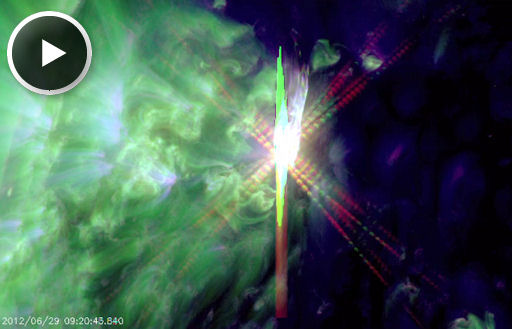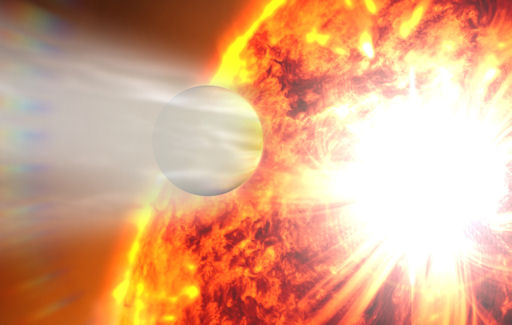Thirty-five new items have just been added to our Meteorite Jewelry collection. Browse the Space Weather Store for something out of this world. | | |
HIDDEN PORTALS IN EARTH'S MAGNETIC FIELD: A NASA-sponsored researcher at the University of Iowa has developed a way for spacecraft to hunt down hidden magnetic portals in the vicinity of Earth. These gateways link the magnetic field of our planet to that of the sun, setting the stage for stormy space weather. [video]
ACTIVE SUNSPOT: Sunspot AR1513 is crackling with impulsive M-class solar flares. NASA's Solar Dynamics Observatory recorded the extreme ultraviolet flash from one of them at 0920 UT on June 29th:

This M2-class flare (like a similar eruption yesterday) illuminated Earth's upper atmosphere with a pulse of X-rays and extreme ultraviolet radiation. Waves of ionization rippled over Europe, altering the propagation of low-frequency radio signals around the continent. Using a receiver tuned to 60 kHz, Rob Stammes detected the sudden ionospheric disturbance over Norway. His antennas also picked up radio waves from the flare itself at 26 MHz and 56 MHz.
More ionization waves and solar radio bursts are in the offing. NOAA forecasters estimate a 30% chance of continued M-flares during the next 24 hours. Solar flare alerts: text, voice.
Realtime Space Weather Photo Gallery
X THREE MILLION: On the Richter Scale of Solar Flares, X3 is considered to be a big explosion. How about X3 million? NASA's Hubble Space Telescope has seen what happens when a planet gets hit by such a flare. This artist's concept, released today by the space agency, illustrates the impact of an X3000000-class stellar flare on exoplanet HD 189733b:

The flare, detected by NASA's Swift satellite, scorched the top of the planet's atmosphere with a powerful blast of ultraviolet radiation and X-rays. Hours later, Hubble detected more than 1,000 tons of gas every second flying away at 300,000 mph. HD 189733b is a gas giant about 14% more massive than Jupiter, so it hardly misses the atmosphere it lost. Millions of years of these flares, however, will eventually make a dent even in such a massive world. So the next time there's an X-flare here in the solar system, just remember, it could be worse.
Realtime Noctilucent Cloud Photo Gallery
[previous years: 2003, 2004, 2005, 2006, 2007, 2008, 2009, 2011]
Potentially Hazardous Asteroids (
PHAs) are space rocks larger than approximately 100m that can come closer to Earth than 0.05 AU. None of the known PHAs is on a collision course with our planet, although astronomers are finding
new ones all the time.
On June 29, 2012 there were potentially hazardous asteroids.
Recent & Upcoming Earth-asteroid encounters: | Asteroid | Date(UT) | Miss Distance | Mag. | Size |
| 2012 MY2 | Jun 29 | 1.3 LD | -- | 24 m |
| 2003 KU2 | Jul 15 | 40.2 LD | -- | 1.3 km |
| 2004 EW9 | Jul 16 | 46.8 LD | -- | 2.1 km |
| 2002 AM31 | Jul 22 | 13.7 LD | -- | 1.0 km |
| 37655 Illapa | Aug 12 | 37 LD | -- | 1.2 km |
| 2000 ET70 | Aug 21 | 58.5 LD | -- | 1.1 km |
| 1998 TU3 | Aug 25 | 49.2 LD | -- | 4.9 km |
| 2009 AV | Aug 26 | 62.8 LD | -- | 1.1 km |
Notes: LD means "Lunar Distance." 1 LD = 384,401 km, the distance between Earth and the Moon. 1 LD also equals 0.00256 AU. MAG is the visual magnitude of the asteroid on the date of closest approach. | | The official U.S. government space weather bureau |
| | The first place to look for information about sundogs, pillars, rainbows and related phenomena. |
| | Researchers call it a "Hubble for the sun." SDO is the most advanced solar observatory ever. |
| | 3D views of the sun from NASA's Solar and Terrestrial Relations Observatory |
| | Realtime and archival images of the Sun from SOHO. |
| | from the NOAA Space Environment Center |
| | the underlying science of space weather |

